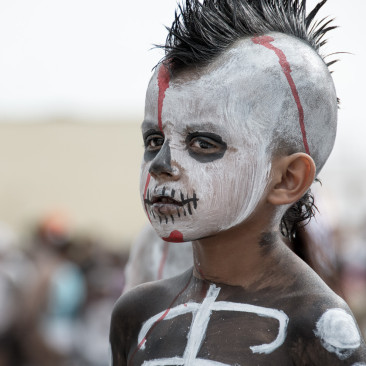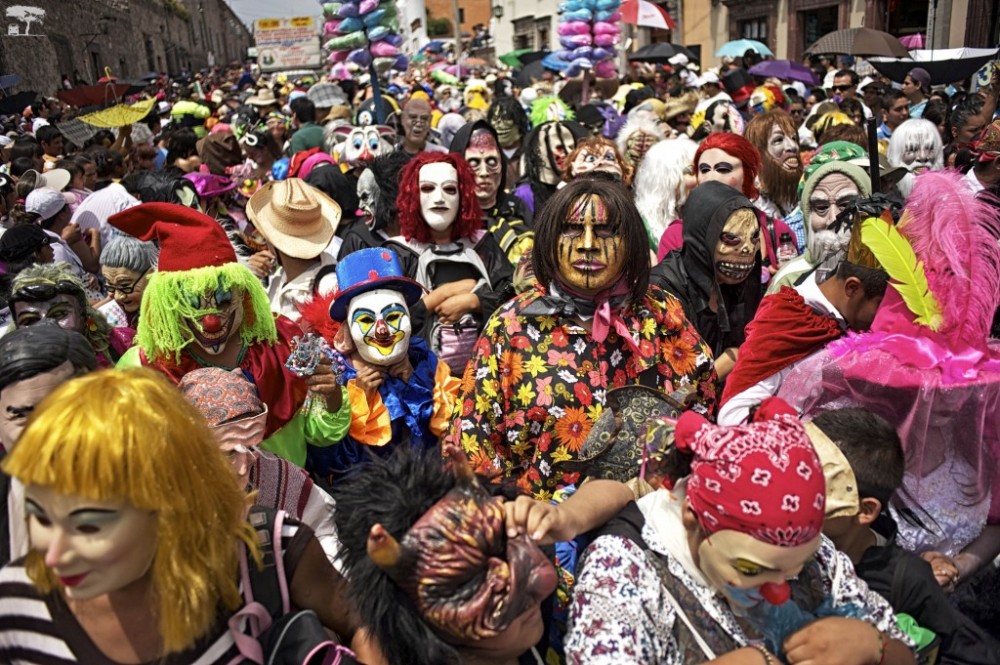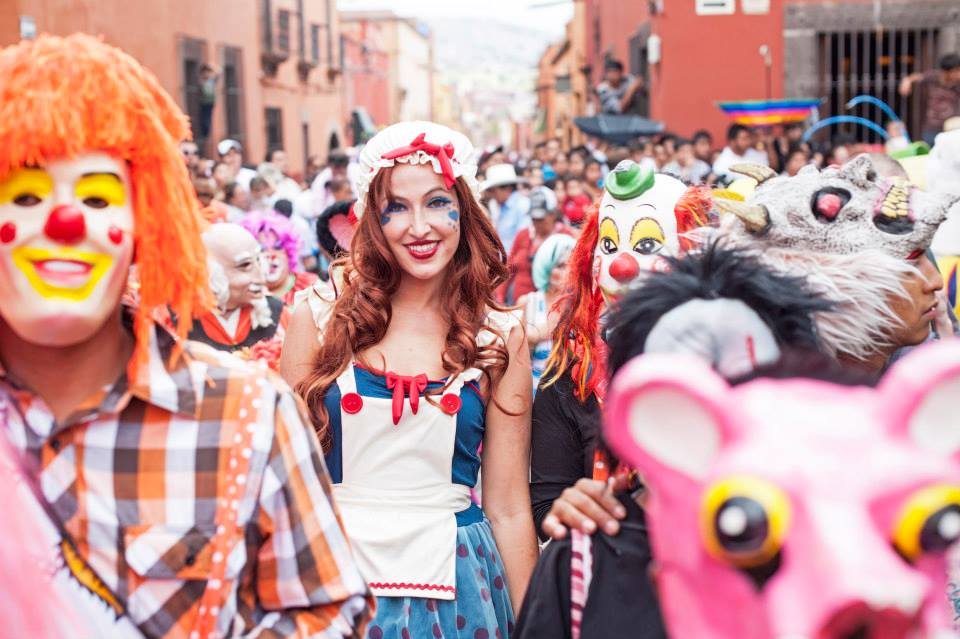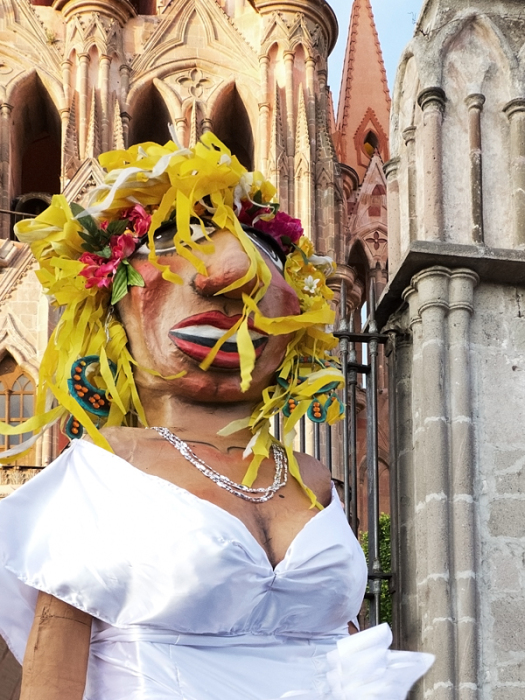Each year the month-long festival of the cross ends in the neighborhood of Valle de Maiz with a bang. The first time I ever danced in public was at the festival and I was terrified. Not of the dancing, I knew the routine and had a great partner, but of the stage itself. Made of warped balsa wood I was certain I was going to fall through the floor like a melting wicked witch.
As the song started so did a battle reenactment between torch-bearing Chichimecas and the Spanish Conquistadors. Never ones to be left out, the Loco dancers featuring clowns, devils and pre-op trannies, joined in the fun while I danced dazon on stage. It’s a memory I’ll not forget and I enjoy coming back to the festival to dance each year.
However, instead of being asked to dance this year I was asked by a couple from India on their honeymoon to provide them a tour of the oldest neighborhoods. Since it was the same day as the Valle de Maiz festival I opted to end the tour there at the festival and opened the tour to the public thinking no one is going to want to go on a hiking tour on a Saturday night.
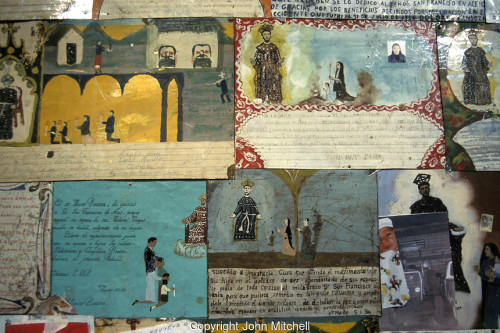
Retablos thanking Saint Francis of Assisi for miracles in the Templo de la Purisima Concepcion, the parish church or parroquia in the 19th-century mining town of Real de Catorce, Mexico. Real de Catorce became a virtual ghost town during the early part of the 20th century. It has recently become a popuar destination for travellers. It is also a Catholic pilgrimage site.
Once again in life, I was wrong. Quickly twenty folks signed up. Then, much to my surprise since I don’t promote where the tour starts as I like to keep groups small, another 50% showed up for the actual tour. I was baffled! Why do so many folks, including many resident foreigners, want to hike in this May heat?
I quickly realized most simply wanted an escort into Valle de Maiz, a neighborhood not known for its tranquility in the past. This particular tour is geared towards hikers and photographers, and is not a tour I normally talk much during but realizing the festival was the draw I felt it was important to explain who would be there and why.
The Chichimecas and Conquistadors – the local hunter gathers fought the Spanish at the Battle of Barbarians in 1530 culminating when a cross appeared in the sky on the feast day of St. Michael. Hence the town’s name and standing as the epicenter of the cult of the cross.
The Sacred Cross – Each area of town (colonias, ranchos, campos) venerates their oldest cross in May. For a long time a cross divided up the neighborhoods and was the only religious item you could have at home. Clever Chichimecas that wanted to worship their own gods simply hollowed out the cross to place their smaller gods inside and out of sight of the Spanish.
Locos – A tradition started by the gardeners of San Miguel in honor of St. Anthony, patron of lost things (“Tony, Tony, come around. Something is lost and can’t be found!”). Today’s loud music and silly costumes are a release from everyday life enabling the participant to more fully express their faith.
Mojigangas – The large paper-mache puppets were brought by the Spanish to teach the lives of the saints. Their long arms cleared the streets of evil spirits prior to the arrival of a priest in a procession. Then they were used to make fun of the Spanish in flamenco dresses and push up bras. Today they lead most wedding parties to the reception.
St. Martha’s Dragon – What appears to be a Chinese New Year’s dragon is actually linked to Jesus’ good pal, Martha. Martha moved to France and tamed the local beast that the villagers then killed (just like in the story of Beauty and the Beast or King Kong). The dragon represents the pagan religions and Martha the Church that converted the indigenous both in Europe and the Americas.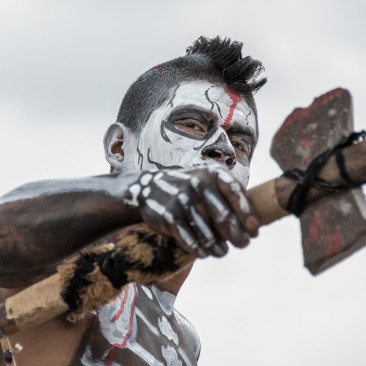
Retablos – the folk art form thanking the Sacred Cross for miracles in everyday life featured in the church in Valle de Maiz. A custom for centuries, retablos died out with the introduction of inexpensive lithographs of religious images and today are collectable folk art featured in museums. Retablos are an expression of faith and gratitude still practiced in Valle de Maiz.
The tour ended with the procession into Valle de Maiz and the start of music and dancing. A group of dancers from the town of Acambaro in the southern part of the state end the show by tossing out the bread their town is famous for. Left for a day or two, it forms the basis for great French toast.
The Valle de Maiz festival continues to be my favorite fiesta in a town well known for its parties!
Joseph Toone is the Historical Society’s short-story award winning author of the SMA Secrets book series. All books in the series are Amazon bestsellers in Mexican Travel and Holidays. Toone is SMA’s expert and TripAdvisor’s top ranked historical tour guide telling the stories behind what we do in today’s SMA. Visit HistoryAndCultureWalkin

